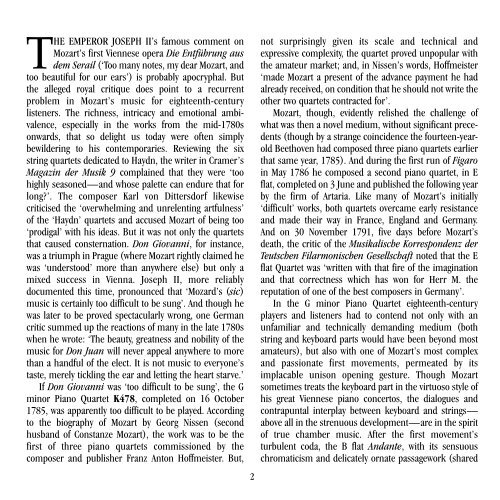PIANO QUARTETS - Abeille Musique
PIANO QUARTETS - Abeille Musique
PIANO QUARTETS - Abeille Musique
You also want an ePaper? Increase the reach of your titles
YUMPU automatically turns print PDFs into web optimized ePapers that Google loves.
T<br />
HE EMPEROR JOSEPH II’s famous comment on<br />
Mozart’s first Viennese opera Die Entführung aus<br />
dem Serail (‘Too many notes, my dear Mozart, and<br />
too beautiful for our ears’) is probably apocryphal. But<br />
the alleged royal critique does point to a recurrent<br />
problem in Mozart’s music for eighteenth-century<br />
listeners. The richness, intricacy and emotional ambivalence,<br />
especially in the works from the mid-1780s<br />
onwards, that so delight us today were often simply<br />
bewildering to his contemporaries. Reviewing the six<br />
string quartets dedicated to Haydn, the writer in Cramer’s<br />
Magazin der Musik 9 complained that they were ‘too<br />
highly seasoned—and whose palette can endure that for<br />
long?’. The composer Karl von Dittersdorf likewise<br />
criticised the ‘overwhelming and unrelenting artfulness’<br />
of the ‘Haydn’ quartets and accused Mozart of being too<br />
‘prodigal’ with his ideas. But it was not only the quartets<br />
that caused consternation. Don Giovanni, for instance,<br />
was a triumph in Prague (where Mozart rightly claimed he<br />
was ‘understood’ more than anywhere else) but only a<br />
mixed success in Vienna. Joseph II, more reliably<br />
documented this time, pronounced that ‘Mozard’s (sic)<br />
music is certainly too difficult to be sung’. And though he<br />
was later to be proved spectacularly wrong, one German<br />
critic summed up the reactions of many in the late 1780s<br />
when he wrote: ‘The beauty, greatness and nobility of the<br />
music for Don Juan will never appeal anywhere to more<br />
than a handful of the elect. It is not music to everyone’s<br />
taste, merely tickling the ear and letting the heart starve.’<br />
If Don Giovanni was ‘too difficult to be sung’, the G<br />
minor Piano Quartet K478, completed on 16 October<br />
1785, was apparently too difficult to be played. According<br />
to the biography of Mozart by Georg Nissen (second<br />
husband of Constanze Mozart), the work was to be the<br />
first of three piano quartets commissioned by the<br />
composer and publisher Franz Anton Hoffmeister. But,<br />
2<br />
not surprisingly given its scale and technical and<br />
expressive complexity, the quartet proved unpopular with<br />
the amateur market; and, in Nissen’s words, Hoffmeister<br />
‘made Mozart a present of the advance payment he had<br />
already received, on condition that he should not write the<br />
other two quartets contracted for’.<br />
Mozart, though, evidently relished the challenge of<br />
what was then a novel medium, without significant precedents<br />
(though by a strange coincidence the fourteen-yearold<br />
Beethoven had composed three piano quartets earlier<br />
that same year, 1785). And during the first run of Figaro<br />
in May 1786 he composed a second piano quartet, in E<br />
flat, completed on 3 June and published the following year<br />
by the firm of Artaria. Like many of Mozart’s initially<br />
‘difficult’ works, both quartets overcame early resistance<br />
and made their way in France, England and Germany.<br />
And on 30 November 1791, five days before Mozart’s<br />
death, the critic of the Musikalische Korrespondenz der<br />
Teutschen Filarmonischen Gesellschaft noted that the E<br />
flat Quartet was ‘written with that fire of the imagination<br />
and that correctness which has won for Herr M. the<br />
reputation of one of the best composers in Germany’.<br />
In the G minor Piano Quartet eighteenth-century<br />
players and listeners had to contend not only with an<br />
unfamiliar and technically demanding medium (both<br />
string and keyboard parts would have been beyond most<br />
amateurs), but also with one of Mozart’s most complex<br />
and passionate first movements, permeated by its<br />
implacable unison opening gesture. Though Mozart<br />
sometimes treats the keyboard part in the virtuoso style of<br />
his great Viennese piano concertos, the dialogues and<br />
contrapuntal interplay between keyboard and strings—<br />
above all in the strenuous development—are in the spirit<br />
of true chamber music. After the first movement’s<br />
turbulent coda, the B flat Andante, with its sensuous<br />
chromaticism and delicately ornate passagework (shared

















